Toyota Supra Review 2024
Written by Lawrence Allan

- 2019
- Sports car
- Petrol
Find your perfect Audi with heycar
Quick overview
Pros
- Strong performance from both engines
- Surprisingly comfortable and refined
- Sharper drive and manual option in 2022
Cons
- More of a GT than a true sports car to drive
- BMW relation is obvious inside
- Some practicality issues may grate
Overall verdict on the Toyota Supra
"The Toyota Supra is stylish, entertaining and surprisingly usable sports car that many people will buy on name alone. Some rivals may have sharper handling, but does that diminish its appeal? Read our full Toyota Supra Review to find out more."
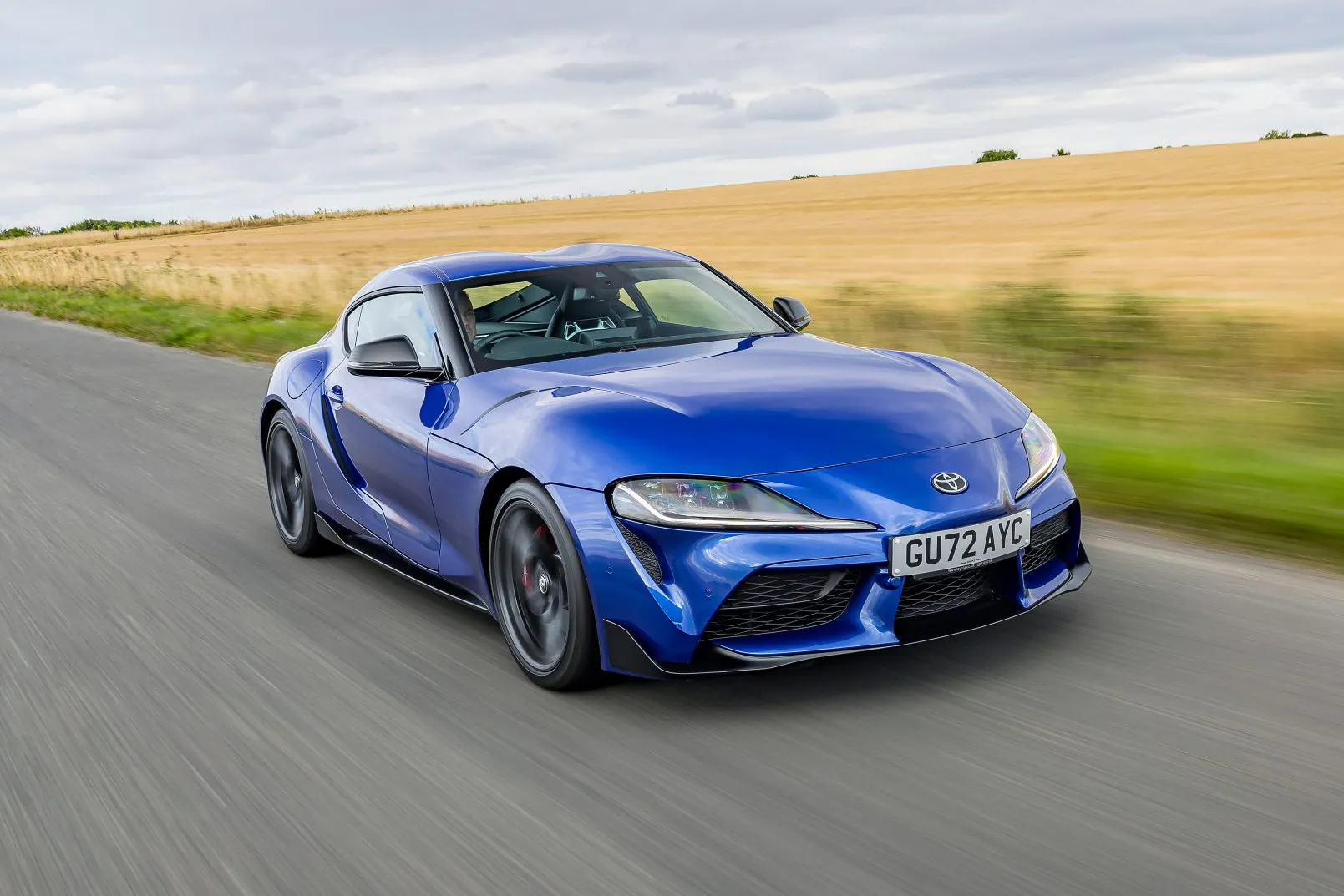
If the words 'Toyota' and 'Supra' don't conjur up a vivid image in your head, you're either not much of a petrolhead or too young to remember what has become a bit of a legend.
Whether it's the early models which showed the Ford Mustang a thing or two by gaining real popularity in America, or the last model that defined the nineties tuning scene with its bulletproof engine and curvy bodywork, car enthusiasts know the Toyota Supra well. Oh, and let's not forget its starring role in the Fast and Furious franchise alongside that other Japanese sports car icon; the Nissan Skyline.
Toyota stopped making the Supra back in 2003, but under its bosses statement that the brand would make "no more boring cars" there was a need to bring the iconic halo model back. Trouble is, fewer people than ever are buying traditional two-seat sports cars today. So how do you make it work? By partnering up with another company to share the costs.
That's why the new Toyota GR Supra is (shock horror) based heavily on the latest BMW Z4 underneath. The two cars were developed alongside each other, with Toyota looking after elements like the exterior styling and fine-tuning the driving experience, and BMW taking care of the bits you can't see like the engine and platform.
The result is a bit controversial, but we'd certainly rather there was a Supra with BMW DNA than no Supra whatsoever. What's more the fundamental Supra attributes are there: it's a low-slung, rear-driven sports car with a straight-six engine option and plenty of poke to satisfy keen drivers.
The 'GR' bit stands for Gazoo Racing, Toyota's sporting division which has plenty of racetrack pedigree. It sits as the halo model in a trio of models under the sub-brand, including the feisty Toyota GR Yaris hot hatchback and the pared-back, fun-at-all-speeds Toyota GR86 sports car.
Like the older Toyota Supra models the new car also sits in a kind of middle ground, providing some of the hardcore thrills of a pure sports car but with a more civilised, comfortable grand touring (GT) approach to the way it drives. The interior, too, is hardly pared-back, with plenty of standard kit and clear BMW influence including a top-notch infotainment system.
Like one of its core rivals, the Porsche 718 Cayman, you can have the Supra in four-cylinder or six-cylinder flavour. Neither is lacking in performance, although purists had to wait until 2022 for the availability of a manual gearbox on the bigger engine.
You'll enjoy driving the Supra on twisty roads, but it's not as talented and confidence-inspiring as the best sports cars partly due to its weight. Some compromise has been made to make the car refined, smooth and comfortable on long distances, which will certainly appeal to many. The engines, too, can be shouty and rapid or smooth and surprisingly efficient when needs be.
The Toyota Supra gained some suspension tweaks alongside that manual gearbox, but this is still a car very much balancing everyday use with handling fun. If it's a pure, lightweight sports car you want an Alpine A110 (or indeed Toyota's own GR86) will be more enjoyable, but for the looks, the long-legged comfort, the sheer potency and that almost unrivalled image we can certainly see appeal in the BMW-ified Supra.
Looking for a used car for sale? We've got 100s of Toyota Approved Used Cars for Sale for you to choose from, including a wide range of Toyota Supras for sale.
Is the Toyota Supra right for you?
Sports cars like the Toyota Supra don't sell in big numbers these days, and a large part of that is the lack of practicality. Modern hot hatchbacks are so multi-talented and capable that many people who have families or commutes find it hard to go for the heart over the head.
Having said that, some people will buy the Supra on looks and image alone. That name carries plenty of weight in enthusiast circles. It's also enjoyable to drive and surprisingly good at long distances, which means if you're lucky enough to have the money for a more sensible daily driver you could go on cross-continental jaunts in your Supra quite happily.
What’s the best Toyota Supra model/engine to choose?
We can see the appeal of the cheaper 2.0-litre model. It's 100kg lighter, which benefits everything from fuel efficiency to cornering agility, and is not exactly slow.
Still, this isn't a delicate sports car even in that form, so if you can afford it we'd recommend going for the 3.0-litre model. The engine feels and sounds more special, while the availability of the manual gearbox means enthusiasts (the sort of people that buy cars like these) will be satisfied.
What other cars are similar to the Toyota Supra?
Given the Toyota Supra is based on the BMW Z4 that's clearly a similar car, although both are aiming for slightly different markets as the Z4 is a convertible and less enthusiast-focused.
Really, the Supra's key rivals are the Porsche 718 Cayman and Alpine A110, which are both similar in ethos, performance and price. We'd also include the hottest Audi TT models - the TTS and TT RS - which are just as fast but more practical, albeit a bit more clinical with it.
Another competitor is the latest BMW 2 Series Coupe, which is available with the same 2.0-litre and 3.0-litre engines as the Supra. The BMW is a bigger, heavier car with room for four, however. The same applies to the Ford Mustang, which is another bigger option but similar in many ways.
Comfort and design: Toyota Supra interior
"Functional but nicely finished and well-equipped, the Toyota Supra doesn't feel like a stripped-out, back-to-basics sports car."
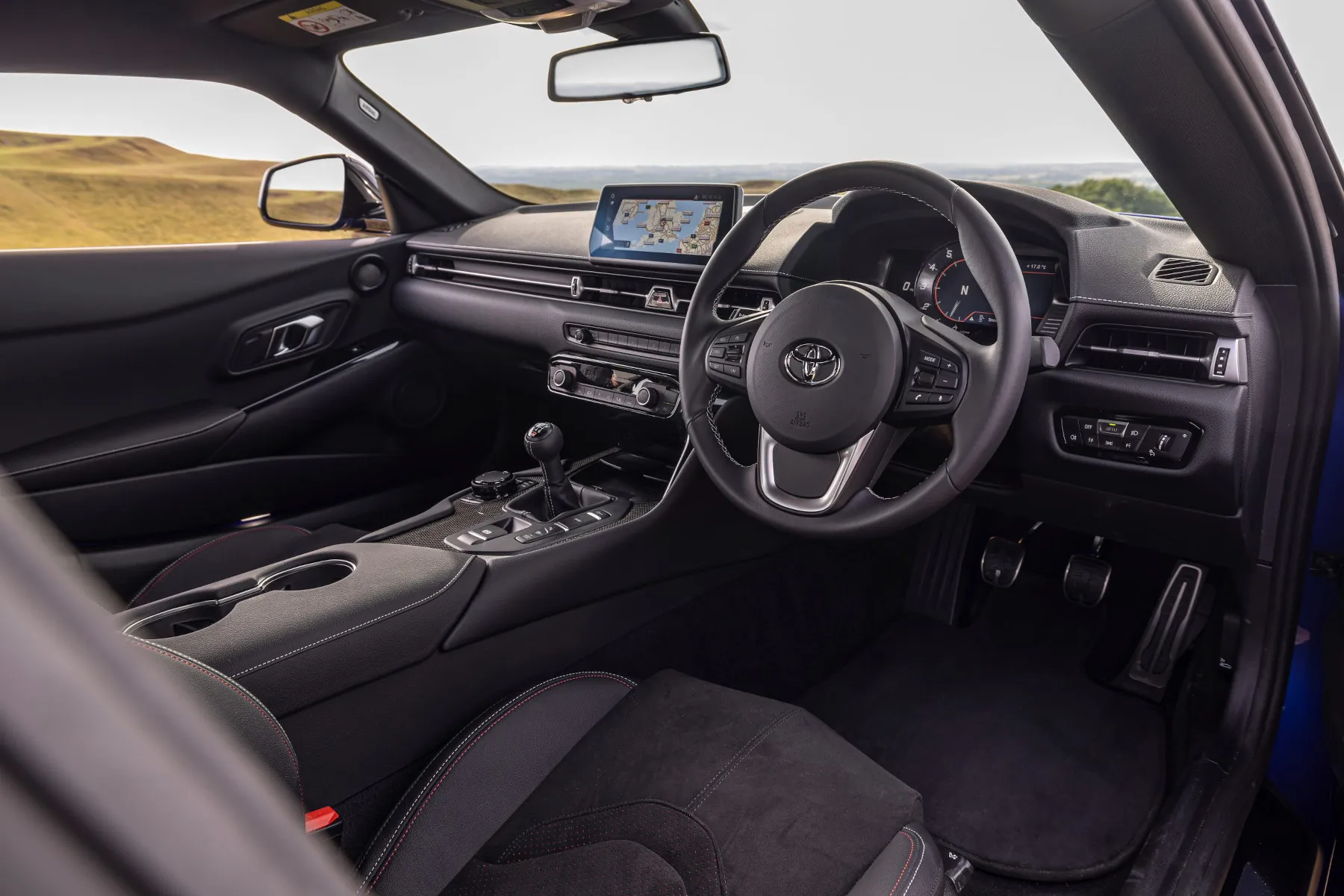
If you've sat in Toyota's GR86 (or indeed the older GT86) you might expect a rather plasticky, low-rent cabin with the emphasis on saving weight rather than luxury. The Toyota Supra isn't that.
It's clear Toyota wanted to justify the Supra's extra cost by making it a more rounded car than a GT86 or GR86. You'll certainly prefer spending long bouts at the wheel here, with comfortable yet supportive seats, good fit and finish and a cocooned feel. Of course the trade-off is that this is a considerably heavier car.
The clear BMW parts-sharing in a lot of the switchgear may put off someone looking for a car that feels bespoke. However it does mean a logical, easy to get on with dash design.
You sit low and far back in the Supra, almost over the rear wheels, with a long and thrusting bonnet ahead. Visibility is okay but hindered by a thin, letterbox-like windscreen and generally high window line necessary to give the Supra its sleek shape.
The seats get adjustable lumbar support and even adjustable side bolsters on all versions, plus electric seats on Pro trim, so it's easy for most shapes and sizes to get comfortable. Indeed our only complaint this 6ft 3 tester had is that the wheel could do with a touch more reach adjustment for optimum comfort, particularly when your left knee is bent to use the clutch in the manual.
Quality and finish
The Toyota Supra feels like a high quality product built with care, as you'd expect with one of the brand's more expensive models. The BMW association helps here, with switchgear lifted straight out of a last-generation 3 Series and delivering on the solidity front.
It's certainly less plasticky and flimsy than the cabin of an Alpine A110, although the 718 Cayman may be even more well-finished overall. It's worth noting that the Porsche's cabin is a bit dour in entry-level trims, whereas the Toyota comes with nice upholstery and lots of kit as standard.
Infotainment: Touchscreen, USB, nav and stereo in the Toyota Supra
One of the many benefits of Toyota partnering with BMW is the former getting access to one of the best infotainment systems in the business.
Standard fitment in the Supra is an 8.8-inch touchscreen using BMW's iDrive software. It might not be the very latest BMW system but in many ways that's a good thing, because it retains the brand's super simple rotary click wheel controller - much easier and safer to use on the move than a touchscreen.
The screen isn't super-sharp but it's clear and the menus are logical, while you get plenty of features. It's certainly better than anything Toyota is fitting to its own in-house models right now and a lot more slick than the rubbish Renault-sourced screen in an Alpine A110. The only downside is that Android Auto isn't included, although Apple CarPlay is.
We like the separate bank of physical controls for the climate functions (again, a BMW unit), although the digital instrument display is unique to Toyota and quite smart. You also get USB connectors, and wireless phone charging is available.
Buyers of the base 2.0-litre model will be sorely disappointed by the lowly four-speaker sound system, so we recommend upgrading to the punchier ten-speaker system or, even better, the JBL 12-speaker system in the 3.0-litre Pro.
Space and practicality: Toyota Supra boot space
Sports cars inevitably mean compromises when it comes to practicality. The Toyota Supra is a low-slung car and a two-seater only, but there's still a decent amount of space to be found. It's certainly roomier than something like a Mazda MX-5.
Passenger space is helped by the curvy 'double bubble' roof, which creates plenty of headroom even for six-plus footers. Legroom is fine, too, because the seats slide well back, while the comfortable seats aren't too restricting for those of broader frame.
Storage is good rather than great, with a decent glovebox, two small door bins, cubbyholes and a pair of cupholders that annoyingly sit right in front of the centre armrest and make it difficult to change gear in the manual.
The Toyota Supra's boot capacity of 290 litres is pretty good for a sports car, and on a par with some superminis. You'll get as much luggage in it as you would in a Porsche 718 Cayman, which splits the space between a front and rear boot. The opening of the hatchback-like tailgate is pretty narrow, though, which restricts what you can get in there. There's also the issue of there being no boot divider meaning your luggage is visible behind the seats - if you carry lots of smelly cheese you won't get away from it.
In terms of exterior dimensions the Toyota Supra is 4379mm long, 1854mm wide and 1299mm tall. That's nearly identical in height and length to a 718 Cayman, although the Supra is wider.
Handling and ride quality: What is the Toyota Supra like to drive?
"The Toyota Supra is not delicate and light like an Alpine, it's more of a brute, albeit one with a softer side that's great for cruising. Newer versions are better, too."
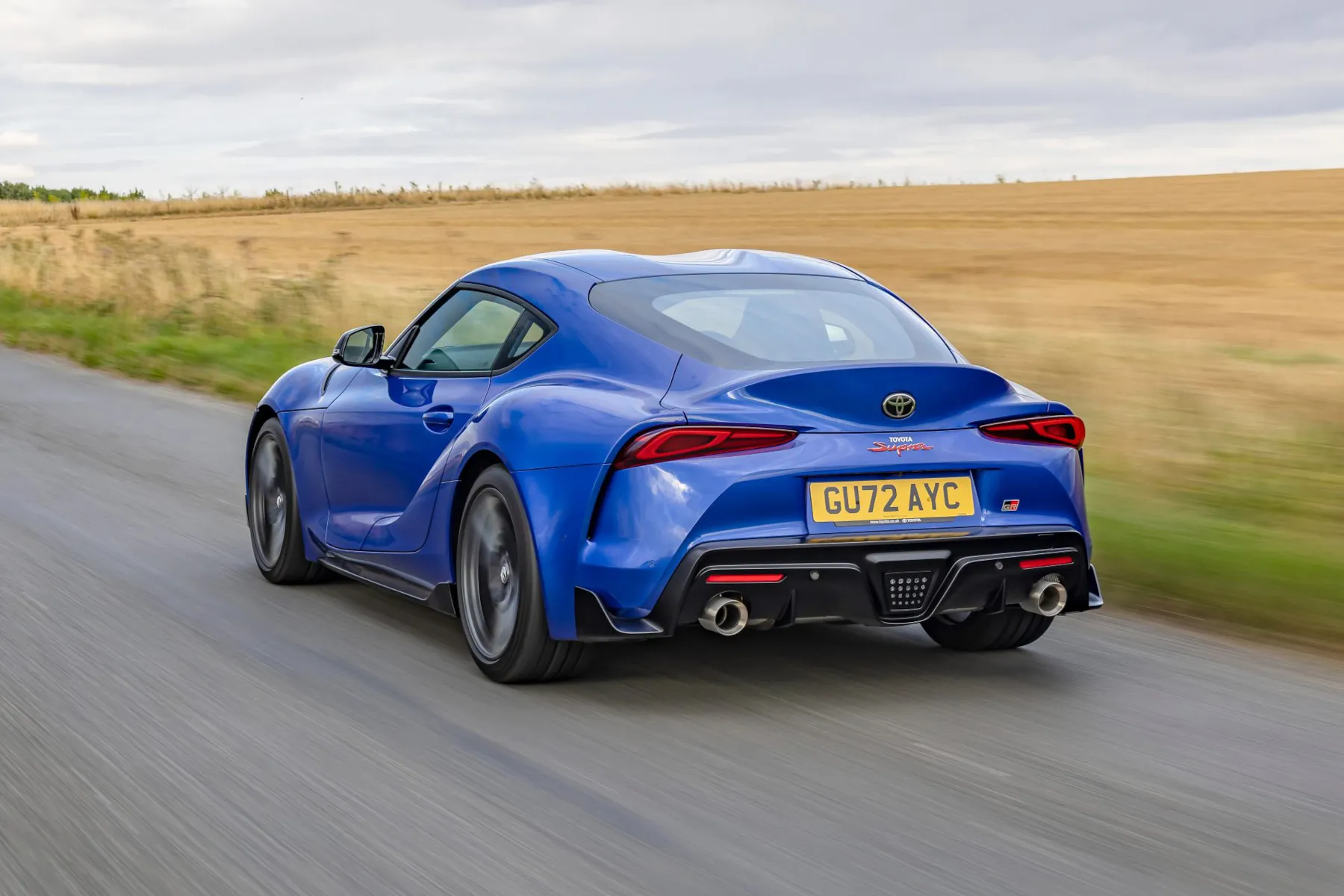
Taking one look at the Toyota Supra's rakish design leaves you expecting much of the driving experience. And it delivers, but in a different way to some thoroughbred sports cars.
Setting off and expecting the precision of a Porsche Cayman or the lightweight feel of the Alpine A110 is a mistake, because the Supra is quite heavy at just under 1400kg in its lightest form up to 1500kg. It's more of a bruiser and in some ways feels like a fast GT car, because its suspension is relatively soft.
That means a surprisingly comfortable ride, ironing out sharp potholes with poise and making a great long-distance car for something of this type. The downside of that is it doesn't have the same level of composure and delicacy in its controls as the Porsche or Alpine, with more body movement in the bends and a rear-end that hops and skips over bumpier country roads. Sticking the adaptive dampers into Sport helps mitigate this somewhat but doesn't totally remove it.
Things were improved by the 2.0-litre model, which is almost 100kg lighter than the 3.0-litre and feels more agile as a result. But Toyota also fiddled with the suspension a bit in 2022, firming a few things up to increase composure without losing the ride comfort. As a result we'd recommend getting a newer model if you can stretch to it.
Even then, this is a car that steers nicely enough and delivers plenty of excitement, but lacks the incredible poise and confidence-building feel of a Porsche or Alpine. Instead the fun comes from keeping it under control in the bends - in the wet or cold the rear-end will step out easily with the traction control in its more relaxed setting which is entertaining, but maybe a bit scary for some. As for turning the traction control off entirely in these conditions? We don't recommend it unless you really know how to handle it.
Others will appreciate the way it moves around and keeps you on your toes rather than flatters you. It thrills with its character and almost thuggish nature, but also has the ability to cruise comfortably and quietly.
What engines and gearboxes are available in the Toyota Supra?
Initially the Toyota Supra was available with one engine sourced from (yep, you guessed it) BMW in the Z4 M40i. It's a 3.0-litre turbocharged straight-six, which despite being German in origin fits nicely with the Supra's heritage.
Developing 340PS and 500Nm of torque it's well-equipped to get a move on, and it's an impressively punchy and flexible engine even at very low revs. It'll also pull right to the redline delivering a creamy (if not exactly snarly) straight-six engine note while doing so, and 0-62mph takes just 4.3 seconds with the eight-speed automatic gearbox.
In 2022 Toyota added a six-speed manual option to the Supra which we've tried. It's certainly more engaging for the keen driver than the slick but clinical automatic, with a nice shift action, although the rather hefty clutch would be a pain in stop-start traffic. 0-62mph is a little slower at 4.6 seconds, but in some ways it feels more dramatic because of the pauses while you shift. It would be our choice if you're not regularly in town. The manual also comes with rev-matching (which blips the engine when you select a lower gear to smooth the shift) which is satisfying to use.
The 2.0-litre turbo four-cylinder engine that came along in 2021 is another unit borrowed from the Z4, with a more modest 258PS and 400Nm of torque. But it is lighter, so with launch control engaged it'll still do 0-62mph in 5.2 seconds. Although the engine note isn't as engaging and it doesn't feel as muscular there's still some driver appeal with the 2.0-litre, and it'll do the job pretty nicely for most. It is automatic-only in most markets, however.
Refinement and noise levels
One reason why the Toyota Supra actually makes a better GT car than outright sports car is how good it is at long-distance cruising. Along with that comfortable ride you get better noise isolation than most (if not all) sports car rivals, with engines that settle down to a whisper on the motorway, very little wind noise and no rattles or squeaks from the cabin.
Granted, there is a bit of road roar kicked up from the big wheels and tyres, but it's less than in a Porsche 718 Cayman and certainly not an annoyance.
Safety equipment: How safe is the Toyota Supra?
Like many low-volume models Euro NCAP has not crash tested the Toyota Supra. However the closely related BMW Z4 scored the maximum five-star rating, with an impressive 97% adult occupant protection figure.
There's also a roster of standard safety equipment to help you prevent having a crash in the first place including automatic emergency braking with pedestrian and cyclist detection, blind-spot monitoring, rear cross-traffic alert and lane assist. There's also adaptive cruise control and road sign assist available on certain models. A rear view camera and (on 3.0-litre models) standard all-round parking sensors help you avoid car park dings.
MPG and fuel costs: What does a Toyota Supra cost to run?
"The Toyota Supra isn't as inefficient and costly to run as you might expect, and the introduction of the cheaper 2.0-litre model has improved matters even further"
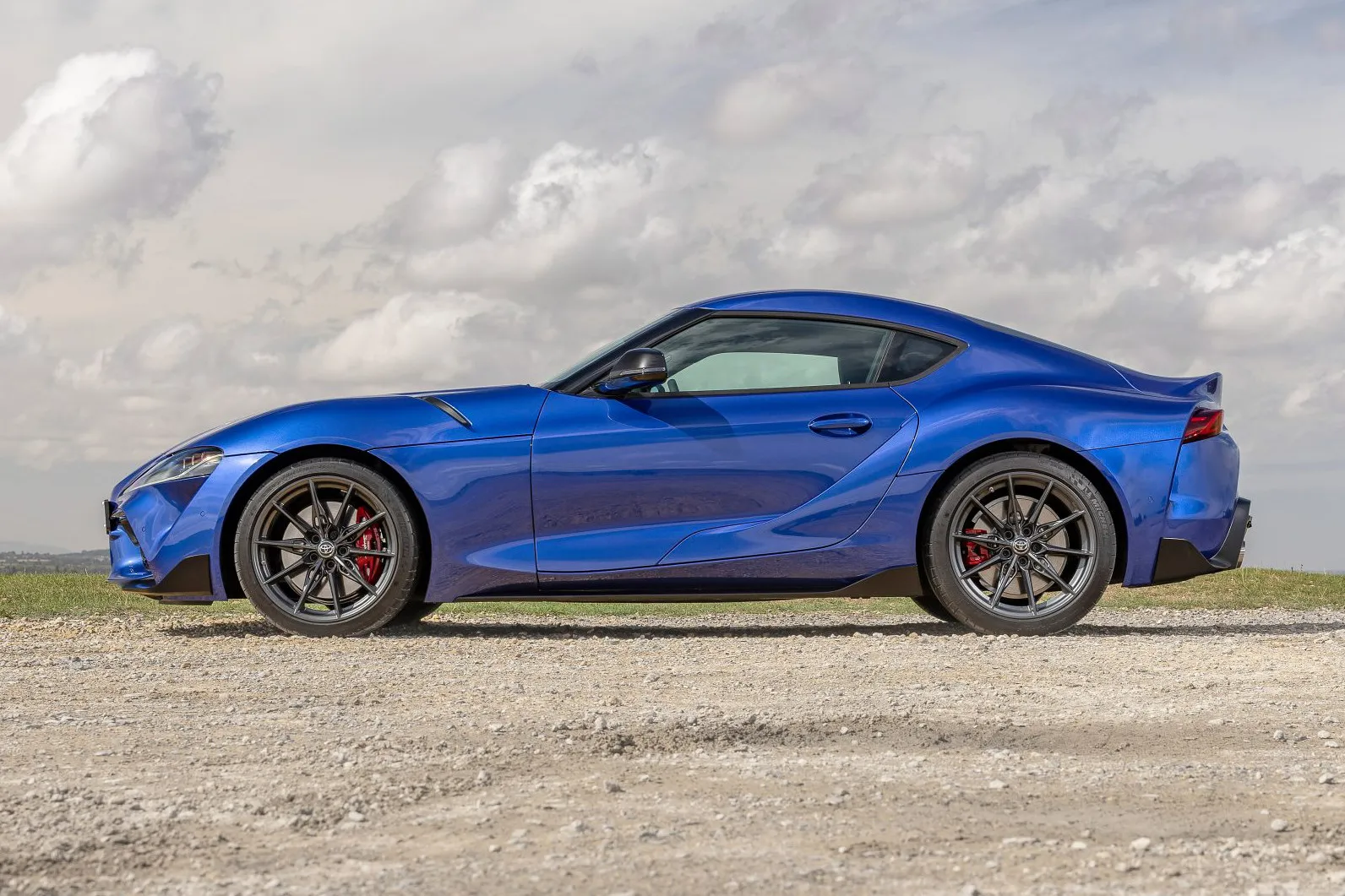
It's interesting to note that the Toyota GR86, which has much less power and is significantly slower, is actually less efficient on paper than the Toyota Supra. You can thank turbocharging and longer gearing for that.
Plumping for the 3.0-litre model with the eight-speed automatic gearbox nets you 34.8mpg on the combined WLTP cycle. In our experience that's a realistic figure in gentle cruising. Flex your right foot more often, though, and that figure will plummet to well into the twenties.
Going for the manual model reduces the official fuel consumption figure to 32.1mpg. Meanwhile the auto-only 2.0-litre model manages a pretty creditable 38.7mpg combined.
How reliable is the Toyota Supra?
It's common knowledge that Toyota has an excellent reputation for quality and durability, building reliable and long-lasting cars for decades. But, remember, the Supra's mechanical bits are largely sourced from BMW, so this particular Toyota is a different kettle of fish.
BMW finished top of the bottom third of brands in the latest HonestJohn.co.uk Satisfaction Index, whereas Toyota finished in the top 10. We've not heard of any particular issues with the Supra yet, but that's likely because relatively few have been sold to report on.
Insurance groups and costs
It came as a surprise to us that the more expensive and more powerful Toyota Supra sits in a noticeably lower insurance bracket than the brand's GR86 sports car. A 2.0-litre Pro sits in insurance group 34, with the 3.0-litre models sitting in group 36 or 37 depending on spec.
Even the least powerful Porsche Cayman sits in group 42, with most models in the high forties, while the Alpine A110 sits in group 44-49. In layman's terms, the Supra should be noticeably cheaper to insure than both.
VED car tax: What is the annual road tax on a Toyota Supra?
The Toyota Supra is relatively efficient for a sports car despite its not inconsiderable weight. The 2.0-litre model's CO2 emissions of 167g/km put it in a first year VED (road tax) band translating to a £585 bill.
The 3.0-litre model also offers lower road tax costs than you might expect with its CO2 emissions of 188g/km, meaning the first year rate is £945. That might sound a lot, but many cars of similar performance are in the band above paying almost £500 more. After the first year it defaults to the £165 a year flat rate.
Sadly for enthusiasts the manual model's higher CO2 figure just tips it into this higher tax band, although it is cheaper to buy in the first place.
Of course, there is the £355 a year 'premium' car tax rate to add on top of those figures regardless of which Supra you go for, because its list price is over £40,000. The same is true of rivals, however.
How much should you be paying for a used Toyota Supra?
"The latest Toyota Supra has been around for a few years now but it's not been a strong seller, so you won't find loads of choice."
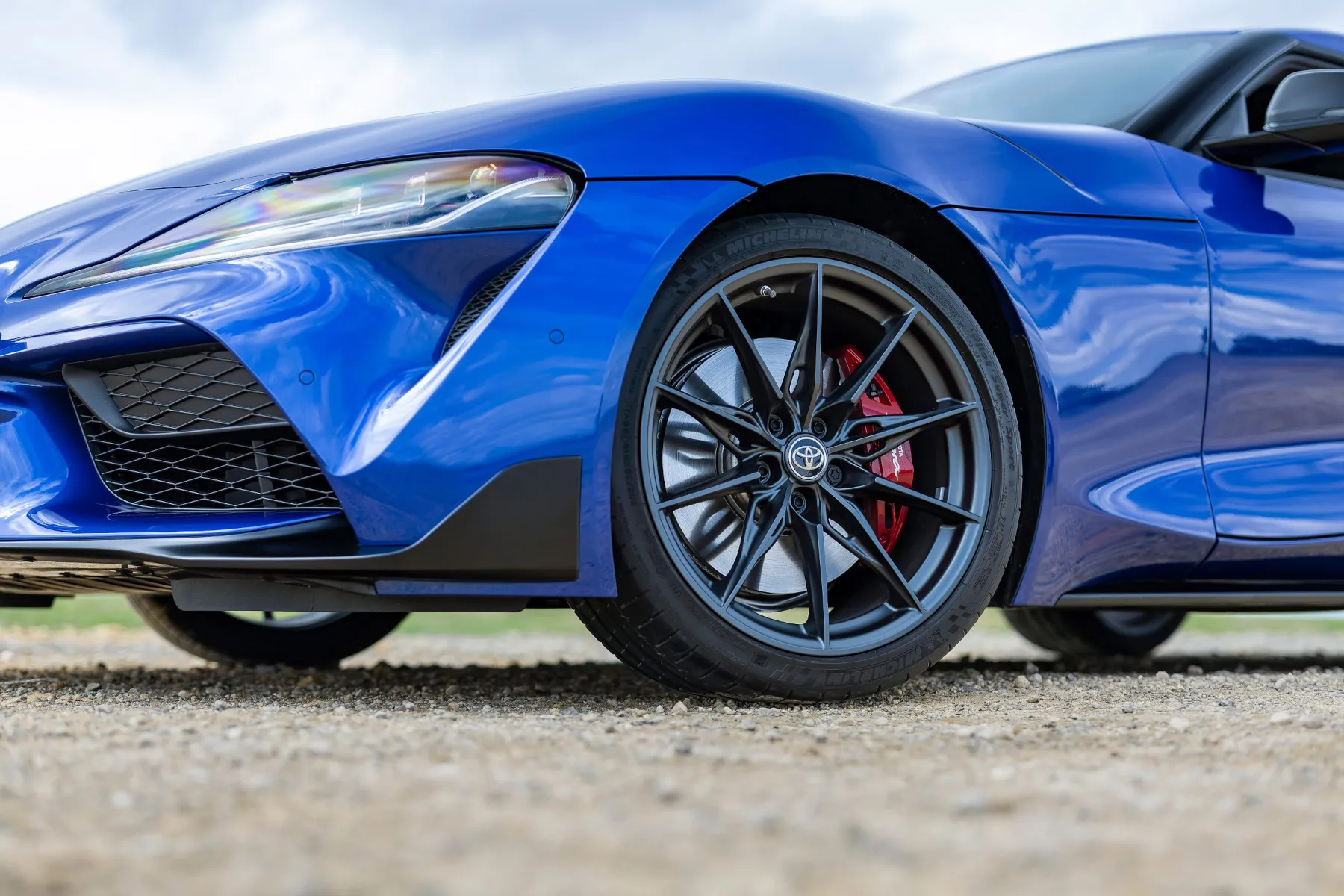
Despite the lack of supply in the used market you can still pick up a 2022 Supra 2.0-litre Pro with just 4,000 miles on the clock for under £40,000, which is a saving of about £10,000 from new.
Stepping up to the 3.0-litre model commands a premium - we saw a 2019 Pro model with 20,000 miles on the clock for £41,000. That's saving of over £16,000 from new.
If you're buying a new Toyota Supra prices in late 2022 start from £49,495, rising to £57,495 for the top-spec 3.0-litre Pro automatic. You'll nab a handy saving by opting for the manual one, which starts at £53,495.
These prices are competitive next to the Porsche Cayman (which starts from a bit less but needs plenty of options ticking to get the same equipment) and the Alpine A110 (which starts from a near identical price but goes over £60k for the top models). Having said that, a 2.0-litre BMW Z4 is noticeably cheaper to buy.
Trim levels and standard equipment
There are two versions of Toyota Supra available to buy new: the standard variant and the higher spec Pro.
The standard Toyota Supra comes equipped with 19-inch alloy wheels, an 8.8-inch touchscreen with navigation, front and rear parking sensors, cruise control, a wireless phone charging pad, a 10-speaker sound system (four speakers on the 2.0-litre), adaptive suspension and Alcantara upholstery.
Upgrading to the Toyota Supra Pro brings features such as leather upholstery, electrically adjustable seats, a head-up display, LED headlights and a 12-speaker JBL sound system, plus exterior upgrades including gloss black trim details.
Ask the heycar experts: common questions
Is the Toyota Supra a BMW?
Is the Toyota Supra a luxury car?
Is the Toyota Supra a fast car?
Get our latest advice, news and offers
Keep me updated by email with the latest advice, news and offers from heycar.
By submitting you agree to our privacy policy


